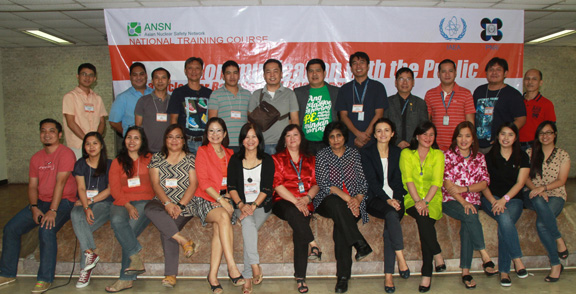
Recognizing the importance of public communication in a well-coordinated preparation and response to emergencies, the Philippine Nuclear Research Institute-Department of Science and Technology (PNRI-DOST) in collaboration with the International Atomic Energy Agency (IAEA) and the Asian Nuclear Safety Network (ANSN) hosted the National Training Course on Communication with the Public in a Nuclear or Radiological Emergency from October 20-24 at the PNRI compound.
Experts from the IAEA and the Greek Atomic Energy Commission (GAEC) handled the week-long training course, emphasizing the need to keep the public informed and the responding agencies credible and prepared well beforehand in case of a nuclear or radiological emergency.
“When you are not responding, you should be planning to respond. This is very important; whatever your requirements, whatever your communication needs, they should all be prepared in advance," said Ms. Bushra Nasim of the IAEA Department of Nuclear Safety and Security – Incident and Emergency Centre.
The course also gave special attention to scenarios such as hoaxes, rumors and overreactions that could cause misinformation and panic in a very volatile situation – as well as the means to prevent them.
“There is uncertainty and anxiety about these events, so our objective as communicators is to prevent the rumors by providing the essential information in order to remove uncertainty. Rumors find a place to grow where there is a gap in information,” said Ms. Vasiliki Tafili of the GAEC International and Public Relations Office.
Representatives from the Philippine National Police (PNP), National Disaster Risk Reduction and Management Council (NDRRMC), Metropolitan Manila Development Authority (MMDA), Bureau of Fire Protection (BFP), Department of Interior and Local Government (DILG), Department of Health (DOH), Science and Technology Information Institute (STII-DOST), Office of Civil Defense (OCD), Philippine Information Agency (PIA) and the National Power Corporation (NPC) participated in the training course. They were also joined by technical experts from the various divisions and sections of PNRI and members of the media.
Lectures on risk communication, radiation basics, and nuclear/radiological incidents were followed by practical exercises on building a public communication program, conducting press conferences, choosing and training agency spokespersons, handling interviews and writing information releases.
The training course also aimed to facilitate collaboration and cooperation between the various government agencies tasked to respond in case a nuclear or radiological emergency happens in the country.
PNRI Director Dr. Alumanda Dela Rosa said that the training course will prove helpful in the revision of the National Radiological Emergency Preparedness and Response Plan (RADPLAN) which will incorporate the lessons learned from the nuclear incident in Japan three years ago. She also expressed the Institute’s desire to continue their collaborative efforts in emergency public communication – nuclear or otherwise.
“I hope that our interaction will also go beyond this course to ensure that the Philippines becomes more prepared in responding to each and every calamity," I am confident that our participants will leave the training course more prepared for future events, whether nuclear, radiological or conventional,” she said.












































